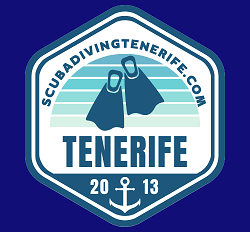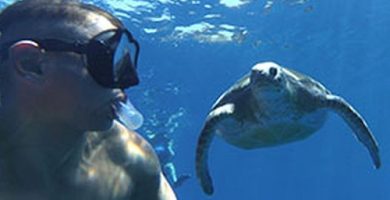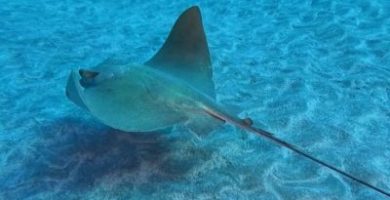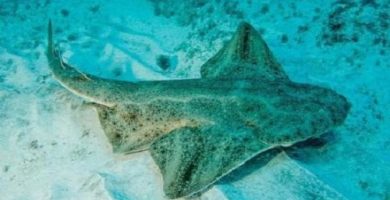In this section you will find the most outstanding marine fauna of Tenerife that you can find during your dives.
45 common species that you can see while diving in Tenerife
- Moray eels: Moray eels are long-bodied, serpentiform fish with a smooth, slimy skin. They are known for their peculiar appearance and their ability to hide in crevices and holes in the seabed.
- Octopuses: Octopuses are intelligent and highly adaptable cephalopods. They have eight tentacular arms and a large head. They are masters of camouflage and can change color and texture to blend in with their surroundings.
- Hermit crabs: These crabs are known to carry empty shells on their back and protect their soft body. They are curious animals and can adapt to different marine habitats.
- Starfish: Starfish are marine echinoderms that have a star-shaped body with several arms. They live at the bottom of the sea and feed on mollusks and other invertebrates.
- Sea turtles: Sea turtles are marine reptiles that spend most of their lives in the water. They are known for their hard shells and their ability to make long migrations. In Tenerife, it is possible to see different species of sea turtles.
- Parrotfish: Parrotfish are colorful and have a strong, serrated, parrot-like beak. They are known for their ability to scrape and bite coral for food.
- Trumpet fish: These fish have an elongated and narrow body, with a tubular mouth similar to a trumpet. They are carnivorous fish that feed mainly on small fish and crustaceans.
- Stingrays and manta rays: Stingrays and manta rays are flat cartilaginous fishes that have disc-shaped bodies. They are known for their graceful swimming and long wings. Different species can be found in the waters of Tenerife.
- Snorers: Snorers are slender-bodied, laterally compressed fish. They have a high dorsal fin and emit a characteristic sound when they feel threatened. They are common fish in coastal waters.
- Sea bream: Sea bream is a fish with a rounded body and silvery scales. It is a saltwater fish highly appreciated in gastronomy. It is found in temperate waters and usually inhabits rocky bottoms and reefs.
- Bogue: The bogue is a fish with an elongated and laterally compressed body, with a silvery coloration and shiny scales. It is commonly found in coastal waters and feeds on algae and small invertebrates.
- Mullet: The mullet is a small to medium-sized fish, with an intense reddish color and shiny scales. It has a high dorsal fin and is highly appreciated in gastronomy. It is found in rocky and sandy bottoms near the coast.
- Bicuda: The bicuda is a predatory fish of elongated and sharp appearance, with a long jaw and full of sharp teeth. It is known for its speed and agility in the water. It can be found in tropical and subtropical waters.
- Vieja: Vieja is a fish with a robust body and brightly colored iridescent scales, such as green and blue. It is a territorial species that inhabits rocky reefs and feeds mainly on algae and small invertebrates.
- Seifia: The seifia is a fish with an elongated and laterally flattened body, a large mouth and sharp teeth. It is a fast swimmer and is found in tropical and subtropical waters. It feeds on small fish and crustaceans.
- Mouse: The mouse is a fish with an elongated and narrow body, with a pointed head and large eyes. It is characterized by its fast swimming and agile movements. It can be found in coral reefs and feeds on small invertebrates.
- Angelshark: The angelshark is a medium-sized shark with a robust body and large dorsal fins. It is a slow swimmer and is found in temperate and tropical waters. It feeds mainly on fish and squid.
- Mutt: The mutt is a medium-sized stingray, with a flat body and a long tail. It is known for its camouflage and its ability to bury itself in the sand. It is found on sandy bottoms and feeds on small fish and crustaceans.
- Sponges: Sponges are multicellular marine organisms that adhere to solid substrates. They have a porous texture and can be found in a wide variety of shapes and colors. They play an important role in marine ecosystems.
- Nudibranchs: Nudibranchs are marine mollusks characterized by their bright colors and striking appearance. They are known for their diversity of shapes and patterns, and many of them are considered species of interest to divers because of their beauty.
- Canary Norway lobster: The Canary Norway lobster is a marine crustacean with an elongated body and long legs. It is characterized by its exquisite flavor and is used in local gastronomy. It can be found in coastal waters and feeds mainly on small organisms.
- Striped burrito: The striped burrito is a small to medium-sized fish with an elongated body and characteristic vertical striped coloration. It is found in coastal waters and feeds on small invertebrates and algae.
- Abade: The abade is a fish with a robust body and brightly colored iridescent scales, such as blue and green. It inhabits rocky reefs and feeds on small fish and crustaceans. It is highly valued in sport fishing.
- Spiny drum: The spiny drum is a strange looking fish, with a globular body and spines on the head and body. It is found on sandy seabeds and feeds mainly on small fish and crustaceans.
- Sargo: Sargo is a medium-sized fish, with an elongated body and shiny scales. It is found in coastal waters and feeds on algae and small invertebrates. It is a common species in the waters of Tenerife.
- Snapper: Snapper is a fish with a robust body and intense reddish coloration. It is found in coastal waters and rocky reefs. It is an appreciated species both in sport fishing and in local gastronomy.
- White Fula: The white fula is a medium-sized fish, with an elongated body and long, pointed fins. It is found in coastal waters and feeds on small fish and crustaceans. It is known for its agility and speed in the water.
- Black coral: Black coral is a species of coral that forms solid, branching black structures. It is found in deep waters and is considered an important habitat for various marine species.
- Canary lobster: The Canary lobster is a marine crustacean with an elongated body and long antennae. It is a species appreciated in gastronomy and is found in rocky bottoms and reefs. Its capture is regulated to guarantee the conservation of the species.
- Barracuda: The barracuda is a medium to large predatory fish with an elongated body and sharp teeth. It is found in coastal waters and feeds on smaller fish. It is known for its speed and agility in the water.
- Seahorse: The seahorse is a marine fish characterized by its unique shape, with an elongated body and a tube-shaped head. They are known for their mating behavior, where the male carries eggs in a pouch on his belly.
- Mantellina: The mantellina is a medium-sized ray species, with a flat body and triangle-shaped fins. It is found in coastal waters and feeds on small fish and crustaceans. It is known for its graceful swimming and its camouflage on the seabed.
- Choco: The choco, also known as cuttlefish, is a marine cephalopod that has a soft, elongated body with tentacles and an inner shell. It is found in coastal waters and feeds mainly on crustaceans and small fish.
- Anemones: Anemones are marine animals that adhere to the substrate and have stinging tentacles. They form a symbiotic relationship with certain fish and crustaceans. Anemones are found in coral reefs and rocky areas and are known for their beauty and color.
- Catalufa: The catalufa, also known as the lemon fish, is a medium to large fish with a fusiform body and bright yellow coloration. It is found in tropical waters and feeds on other fish and cephalopods.
- Shrimp: Shrimp are marine crustaceans that have an elongated, segmented body with legs adapted for swimming and capturing food. They are found in coastal waters and are an important food source for many marine species.
- Sprouts: Sprouts are small marine crustaceans found in shallow coastal waters. They have a compressed body and long abdominal fins that allow them to swim. They are a food source for many marine species.
- Franciscan marias: Franciscan marias are sea stars that have a flattened body and long, slender arms. They are found in coastal waters and feed mainly on detritus and organic matter on the seafloor.
- Groupers: Groupers are large marine fish with a robust body. They are characterized by a large mouth and strong jaws. They are found in coral reefs and feed on smaller fish. They are a species of interest for sport fishing.
- Cabrillas: Cabrillas are medium-sized marine fish, with an elongated body and prominent dorsal spines. They are found in coastal waters and feed on crustaceans and small fish.
- Scorpionfishes: Scorpionfish are marine fish of peculiar appearance, with a compressed body and prominent spines on the fins and back. They are found in rocky coastal waters and feed on crustaceans and other marine invertebrates.
- Pejeverde: The pejeverde, also known as salpa, is a marine fish with a transparent body and cylindrical shape. They are found in tropical waters and feed on plankton. They are known for their ability to move in large schools and for their asexual reproduction.
- Fula: The fula, also known as the salmon or largemouth, is a medium to large marine fish. They have an elongated body and prominent dorsal and anal fins. They are found in tropical waters and feed on small fish and crustaceans.
- Pejepipa: The pejepipa is a marine fish with an elongated and narrow body. They have a large mouth and strong jaws. They are found in coastal waters and feed on small fish and crustaceans.
- Spirograph: The spirograph is a marine worm that lives in calcareous tubes and has branched spiral tentacles. They are found on sandy seabeds and feed on suspended organic particles.



